You are using an out of date browser. It may not display this or other websites correctly.
You should upgrade or use an alternative browser.
You should upgrade or use an alternative browser.
Export thread
gxv140 Rebuild Question - do I go further?
#1

KC_kid
KC_kid
I had a problem last fall where something seemed to break inside the engine - loud banging internal to the engine. I shut it down before any catastrophic failure happened and the engine did not seize. I decided to open it up and have a look to see if I could fix it.
I pulled the engine and removed the oil pan and found that the bolts holding the connecting rod assembly to the crankshaft where backed out so far the lower cap was almost completely off. You can see in the picture where the bolts are backed out.
My question is: do I continue tearing down the engine or just tighten the connecting rod bolts to spec and put it back together? Right now the only new parts are a oil pan gasket and maybe a lower oil seal, I haven't even removed the head. I could remove the head to see what's going on and then potentially replace the rings, they cost $20. But I've never deglazed or honed cylinder walls before.
Any suggestions? I have had a lot of overheating problems with this mower in the past. I think I fixed it by no longer running higher octane fuel. Also notice how dirty it is, very sludgy oil, I suspect from overheating. This oil is less than 1 season of mowing in kansas city area.

I pulled the engine and removed the oil pan and found that the bolts holding the connecting rod assembly to the crankshaft where backed out so far the lower cap was almost completely off. You can see in the picture where the bolts are backed out.
My question is: do I continue tearing down the engine or just tighten the connecting rod bolts to spec and put it back together? Right now the only new parts are a oil pan gasket and maybe a lower oil seal, I haven't even removed the head. I could remove the head to see what's going on and then potentially replace the rings, they cost $20. But I've never deglazed or honed cylinder walls before.
Any suggestions? I have had a lot of overheating problems with this mower in the past. I think I fixed it by no longer running higher octane fuel. Also notice how dirty it is, very sludgy oil, I suspect from overheating. This oil is less than 1 season of mowing in kansas city area.

#3

KC_kid
KC_kid
There was definitely some tiny bits of metal in the old sludgy oil, like metal dust, very fine. I poured some Seafoam to release some of the sludge and the mixture that came out had the metal dust in it.
I think I've convinced myself to go ahead and remove the cylinder to hone and replace rings. I might as well since I'm into this far and the engine will be 16 years old this spring. I hope to use it for many more years.
I think I've convinced myself to go ahead and remove the cylinder to hone and replace rings. I might as well since I'm into this far and the engine will be 16 years old this spring. I hope to use it for many more years.
#5
B
bertsmobile1
B
bertsmobile1
Pull it apart fully and at a minimum replace the rod.
Once the bolts get a little loose it pounds against the journal and goes flat.
having gottem that loose it will have stressed and there will either be visible cracks or subsurface cracks.
Whne you get it out, break it in 1/2 so it never gets accidentally reinstalled.
A new rod is not expensive in fac down here the rebuild gasket kit is more expensive than the rod.
Before you push the piston out of the top of the bore, clen off the ridge of hard carbon at the lip or you will damage the rings and piston beyond repair
Clean out the crankcase good enough to eat off it and then buy a spray on crack detecor kit.
Google Turco Crack detection and you should find a supplier.
Most real auto parts stores carry them, you know the ones that have more engine parts than flashy mirrors and disco lights.
Check any spots where it looks like and impact has happened also the boss where the crank & cam run.
Any time I get that deep into a motor I take the oppertunity to fit new rings as the cost is minimal and that will add another 5 years or so to the life of the engine.
Finally your engine is getting way too hot judging from that photo so check the goverened fast idle speed when you have it back together and make sure you keep the surface of the engine clear of debris so the cooling air can do its job.
Once the bolts get a little loose it pounds against the journal and goes flat.
having gottem that loose it will have stressed and there will either be visible cracks or subsurface cracks.
Whne you get it out, break it in 1/2 so it never gets accidentally reinstalled.
A new rod is not expensive in fac down here the rebuild gasket kit is more expensive than the rod.
Before you push the piston out of the top of the bore, clen off the ridge of hard carbon at the lip or you will damage the rings and piston beyond repair
Clean out the crankcase good enough to eat off it and then buy a spray on crack detecor kit.
Google Turco Crack detection and you should find a supplier.
Most real auto parts stores carry them, you know the ones that have more engine parts than flashy mirrors and disco lights.
Check any spots where it looks like and impact has happened also the boss where the crank & cam run.
Any time I get that deep into a motor I take the oppertunity to fit new rings as the cost is minimal and that will add another 5 years or so to the life of the engine.
Finally your engine is getting way too hot judging from that photo so check the goverened fast idle speed when you have it back together and make sure you keep the surface of the engine clear of debris so the cooling air can do its job.
#6

KC_kid
Thanks for the info, I'll put a new rod on my list of new parts and thanks for the tip with removing the piston.
I see that you feel there must have been a big impact on the engine, do you mean externally like something hit it or do mean internally from the rod banging around? I get the idea to look for cracks in the case but I'm not aware that it took any impact. The loud banging I heard started all at once. I was mowing the yard for about 30-45 minutes and then the banging started, then I immediately shut it down. I tested the rope to make sure it wasn't seized and it actually started back up, and I shut down again immediately. It probably didn't operate for a total of 10-15 seconds banging like that. I'm surprised to see those bolts so loose with it happening so quickly.
For the overheating... in 2014 I was running 91 octane fuel and the mower would overheat and stop running during every use. I couldn't figure it out and I finally pointed the finger at the higher octane fuel. Not really sure if that was the real cause because I still feel like it was getting too hot throughout the 2015 mowing season even though it never overheated to the point of shutting down. See my thread about that, I replaced about everything I could external to the engine - coil, filter, carb, spark, cleaned, flushed tank etc. I still don't know what was causing the overheating issue and I'm worried that it will continue after the rebuild.
http://www.lawnmowerforum.com/honda-forum/28935-gxv140-overheating.html
For cleaning the internal of the engine, what product do I use to accomplish that? I don't want to use the wrong thing and ruin it.
Thanks for all the help!
KC_kid
Finally your engine is getting way too hot judging from that photo so check the goverened fast idle speed when you have it back together and make sure you keep the surface of the engine clear of debris so the cooling air can do its job.
Thanks for the info, I'll put a new rod on my list of new parts and thanks for the tip with removing the piston.
I see that you feel there must have been a big impact on the engine, do you mean externally like something hit it or do mean internally from the rod banging around? I get the idea to look for cracks in the case but I'm not aware that it took any impact. The loud banging I heard started all at once. I was mowing the yard for about 30-45 minutes and then the banging started, then I immediately shut it down. I tested the rope to make sure it wasn't seized and it actually started back up, and I shut down again immediately. It probably didn't operate for a total of 10-15 seconds banging like that. I'm surprised to see those bolts so loose with it happening so quickly.
For the overheating... in 2014 I was running 91 octane fuel and the mower would overheat and stop running during every use. I couldn't figure it out and I finally pointed the finger at the higher octane fuel. Not really sure if that was the real cause because I still feel like it was getting too hot throughout the 2015 mowing season even though it never overheated to the point of shutting down. See my thread about that, I replaced about everything I could external to the engine - coil, filter, carb, spark, cleaned, flushed tank etc. I still don't know what was causing the overheating issue and I'm worried that it will continue after the rebuild.
http://www.lawnmowerforum.com/honda-forum/28935-gxv140-overheating.html
For cleaning the internal of the engine, what product do I use to accomplish that? I don't want to use the wrong thing and ruin it.
Thanks for all the help!
#7

KC_kid
KC_kid
I don't have a puller so I couldn't get the fly wheel off, I'll have to borrow from the parts store puller tomorrow. Please advise per the photos... I have a bad feeling about what is possible to save. The bearings look pretty bad and the piston has some major scoring on one side. The bore doesn't look as bad as the piston and I'm not sure how bad the rod journal is. I have more pictures if you want to see them.
Can anyone explain my options? Do I need to find a replacement engine or is a replacement even an option? I'd like to find something with the hydro-static transmission output shaft.
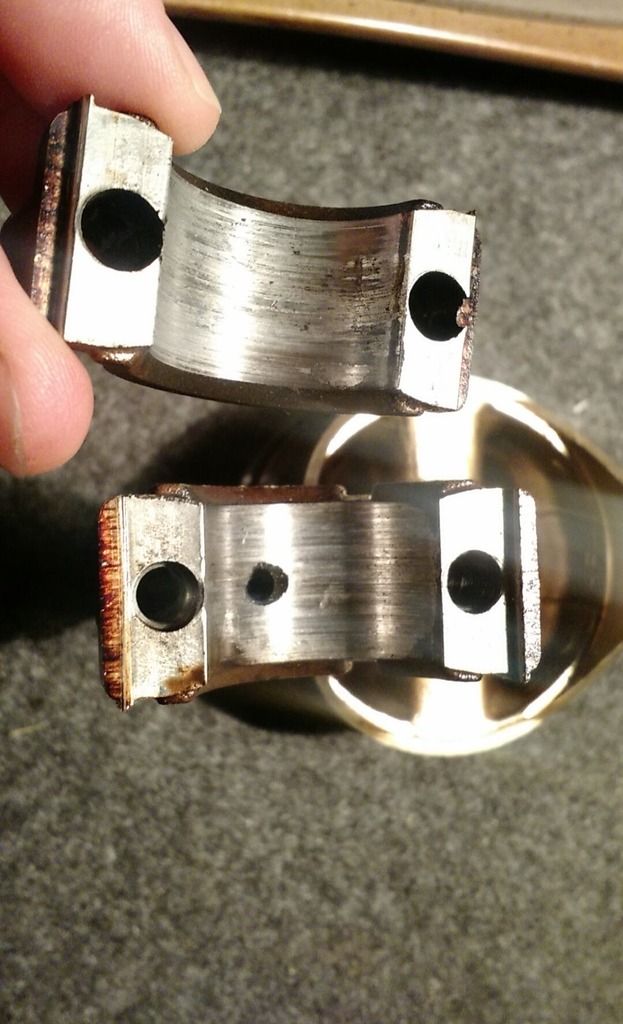
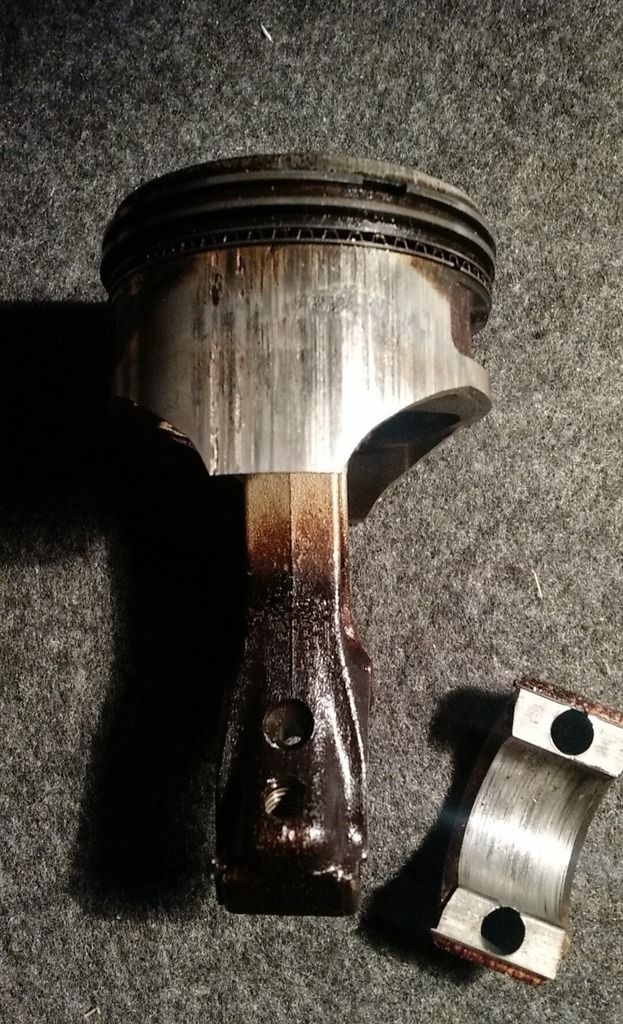
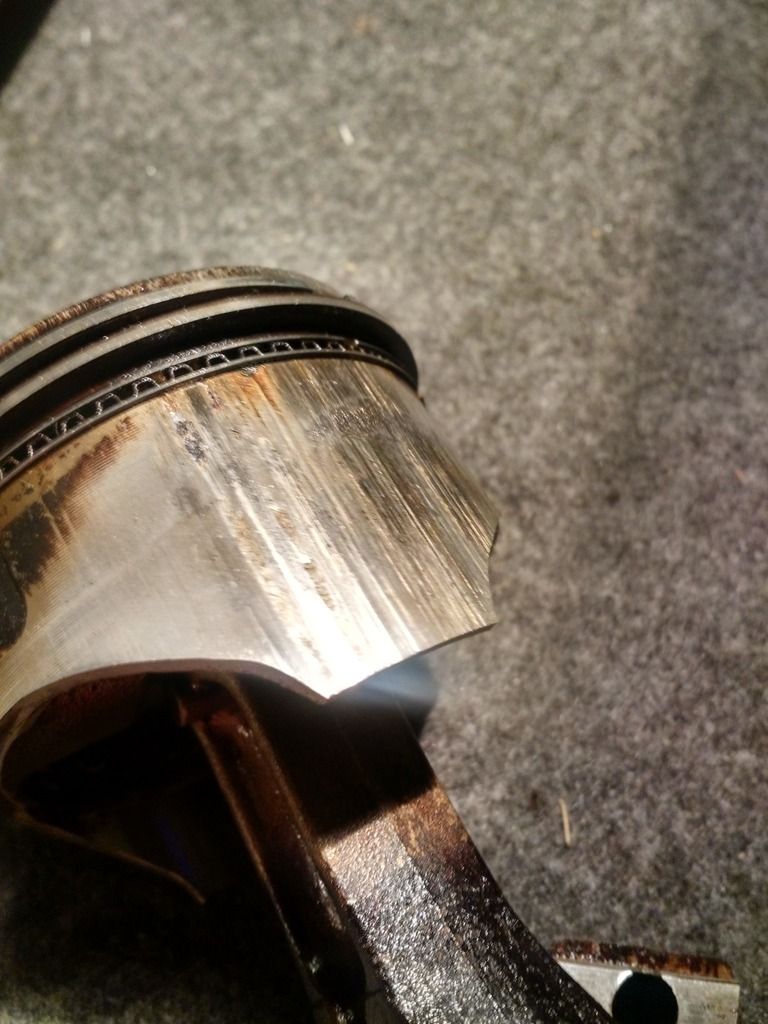

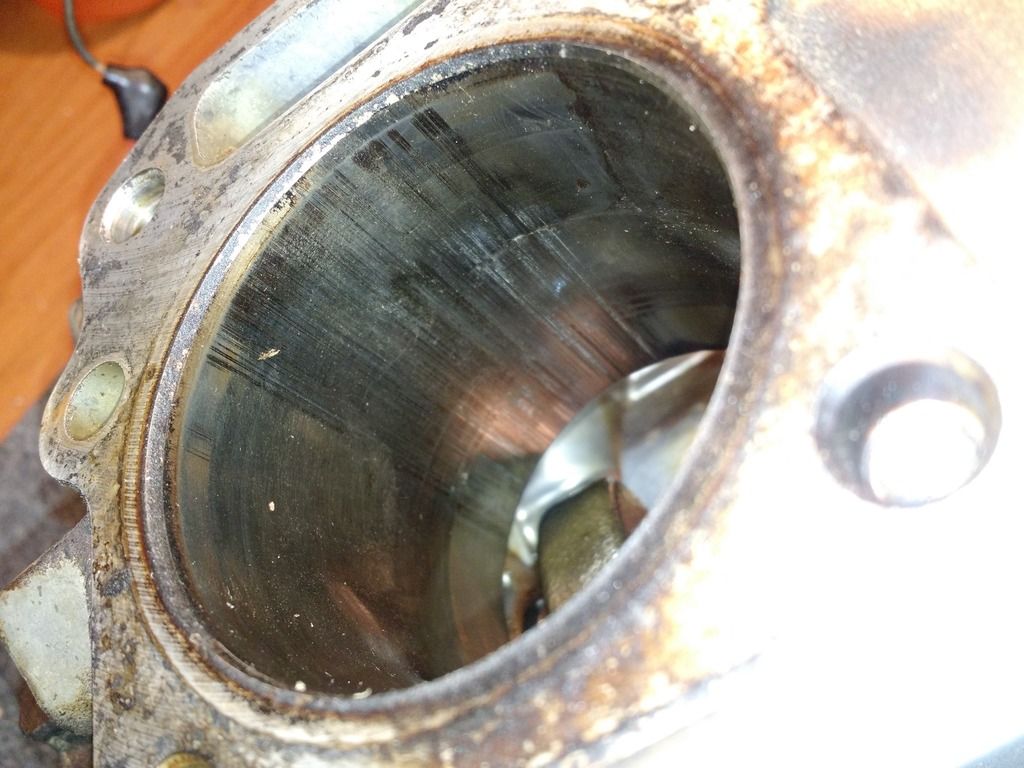
Can anyone explain my options? Do I need to find a replacement engine or is a replacement even an option? I'd like to find something with the hydro-static transmission output shaft.





#9
B
bertsmobile1
B
bertsmobile1
Pison is scrap
Rod is scrap
Barrel looks suspect
Crank will clean up with a dip in hydrochloric acid, also called muriatic acid followed by several washes in clean water followed by chlorine and a hot water final rince.
Chlorine & acid will come from a pool company standard chemicals for adjusting the pH of your swimming pool.
If the scrathes in the bore are deep enough to catch your fingernail then it will need to be bored out to the next oversize and an ovesized piston fitted
The dark brown stains are the result of very heavy overheating and unless you were mowing for 3 to 4 hours strait in 80 deg air temperatures were due to something a lot more sinister than too high an octane fuel.
Most likely an air leak between the carb & engine or judging from what I can not see insufficant oil circulation.
What does the crown of the piston look like and the inside of the piston crown.
What actually was happening is the engine was getting way too hot and the rod was expanding enough to stretch the bolts slightly.
when the engine cooled down, the bolts were then too slack so not enough oil was retained around the journal which again got way too hot stretching the bolts and collapsing the area around the nuts on the rod.
The cycle continues the rod then gets looser till the vibrations are enough to unwind the nuts and you end up where you are now.
What is missing from the photo is the dipper, a little scoop type of thingie that splashed the oil all around the engine so some can drop into the holes and lube the bearing.
AFAIK Honda use a steel cap that fits under the rod bolts to dip the oil and this has a couple of tabs that fold up to stop the nuts backing off but Robert is the one to confirm this.
If they are missing then you might have a warrante claim if it can be established the engine has not been apar before & there was no dipper fitted ex-factory.
Without a dipper the engine will drastically overheat first at the little end then at the big end then usually sieze & break a rod.
The oil thicken as you suggested in your first post which again adds to the lack of circulation problem till eventually it goes bang & stops.
Rod is scrap
Barrel looks suspect
Crank will clean up with a dip in hydrochloric acid, also called muriatic acid followed by several washes in clean water followed by chlorine and a hot water final rince.
Chlorine & acid will come from a pool company standard chemicals for adjusting the pH of your swimming pool.
If the scrathes in the bore are deep enough to catch your fingernail then it will need to be bored out to the next oversize and an ovesized piston fitted
The dark brown stains are the result of very heavy overheating and unless you were mowing for 3 to 4 hours strait in 80 deg air temperatures were due to something a lot more sinister than too high an octane fuel.
Most likely an air leak between the carb & engine or judging from what I can not see insufficant oil circulation.
What does the crown of the piston look like and the inside of the piston crown.
What actually was happening is the engine was getting way too hot and the rod was expanding enough to stretch the bolts slightly.
when the engine cooled down, the bolts were then too slack so not enough oil was retained around the journal which again got way too hot stretching the bolts and collapsing the area around the nuts on the rod.
The cycle continues the rod then gets looser till the vibrations are enough to unwind the nuts and you end up where you are now.
What is missing from the photo is the dipper, a little scoop type of thingie that splashed the oil all around the engine so some can drop into the holes and lube the bearing.
AFAIK Honda use a steel cap that fits under the rod bolts to dip the oil and this has a couple of tabs that fold up to stop the nuts backing off but Robert is the one to confirm this.
If they are missing then you might have a warrante claim if it can be established the engine has not been apar before & there was no dipper fitted ex-factory.
Without a dipper the engine will drastically overheat first at the little end then at the big end then usually sieze & break a rod.
The oil thicken as you suggested in your first post which again adds to the lack of circulation problem till eventually it goes bang & stops.
#10

robert@honda
I do not think the GXV (vertical shaft, lawn mower engines) in the HR215 had a dipper on the connecting rod cap. A dipper was usually included on horizontal-shaft engines (pressure washers, reel mowers, generators, etc.) This is not a 100% hard & fast rule. I have seen some mower engines that do indeed have a dipper, but it was included to reduce overall costs, by sharing the same connecting rod cap as a horizontal-shaft engine.
robert@honda
AFAIK Honda use a steel cap that fits under the rod bolts to dip the oil and this has a couple of tabs that fold up to stop the nuts backing off but Robert is the one to confirm this.
If they are missing then you might have a warrante claim if it can be established the engine has not been apar before & there was no dipper fitted ex-factory.
Without a dipper the engine will drastically overheat first at the little end then at the big end then usually sieze & break a rod.
I do not think the GXV (vertical shaft, lawn mower engines) in the HR215 had a dipper on the connecting rod cap. A dipper was usually included on horizontal-shaft engines (pressure washers, reel mowers, generators, etc.) This is not a 100% hard & fast rule. I have seen some mower engines that do indeed have a dipper, but it was included to reduce overall costs, by sharing the same connecting rod cap as a horizontal-shaft engine.
#11
B
bertsmobile1
Well you are the bloke who would know.
It is a testiment to the quality of the Honda engines that I rarely have to dive deep inside.
In tha past 4 years the only Honda work I have done a lot of is cleaning the crud out of the carbs and replacing main jets and fuel bowls devoid of the zinc plating.
This is of course apart from general service & tuning.
Not had a single failure requireing splitting the cases.
OTOH that rod is definatlely cooked and cooked from the journal up not from the piston down which is what too high octane gas / running lean would do.
Will you show the pickies to the tech Gurus for a more authorative opinion than mine ?
B
bertsmobile1
I do not think the GXV (vertical shaft, lawn mower engines) in the HR215 had a dipper on the connecting rod cap. A dipper was usually included on horizontal-shaft engines (pressure washers, reel mowers, generators, etc.) This is not a 100% hard & fast rule. I have seen some mower engines that do indeed have a dipper, but it was included to reduce overall costs, by sharing the same connecting rod cap as a horizontal-shaft engine.
Well you are the bloke who would know.
It is a testiment to the quality of the Honda engines that I rarely have to dive deep inside.
In tha past 4 years the only Honda work I have done a lot of is cleaning the crud out of the carbs and replacing main jets and fuel bowls devoid of the zinc plating.
This is of course apart from general service & tuning.
Not had a single failure requireing splitting the cases.
OTOH that rod is definatlely cooked and cooked from the journal up not from the piston down which is what too high octane gas / running lean would do.
Will you show the pickies to the tech Gurus for a more authorative opinion than mine ?
#12

KC_kid

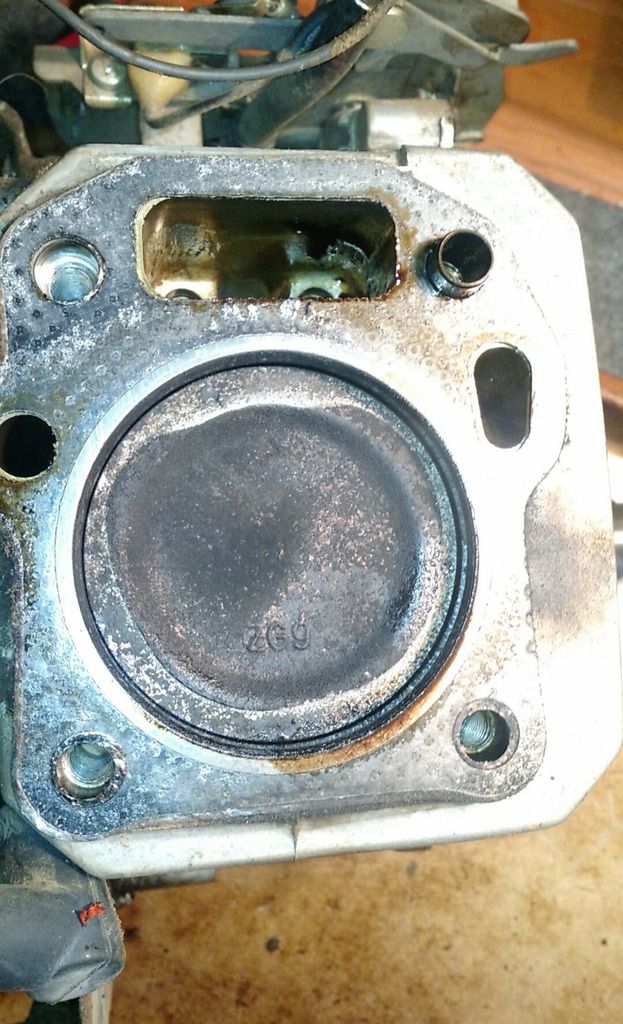
I would feel more comfortable buying a new piston and boring it (if needed) if I could verify why it had such an overheating problem. I don't want that to continue if I rebuild it. If you read my other thread on that topic, I tried everything I could think of. We have Kansas heat but its only about an hours worth of mowing and nothing to strenuous for the mower. I almost always mulch.
I agree, the bottom of the motor looks like it got much hotter than the top. I replaced all of the carb gaskets and remember searching that area for leaks. I'm stumped on the overheating, which is what caused all of this. Here is the oil pan:
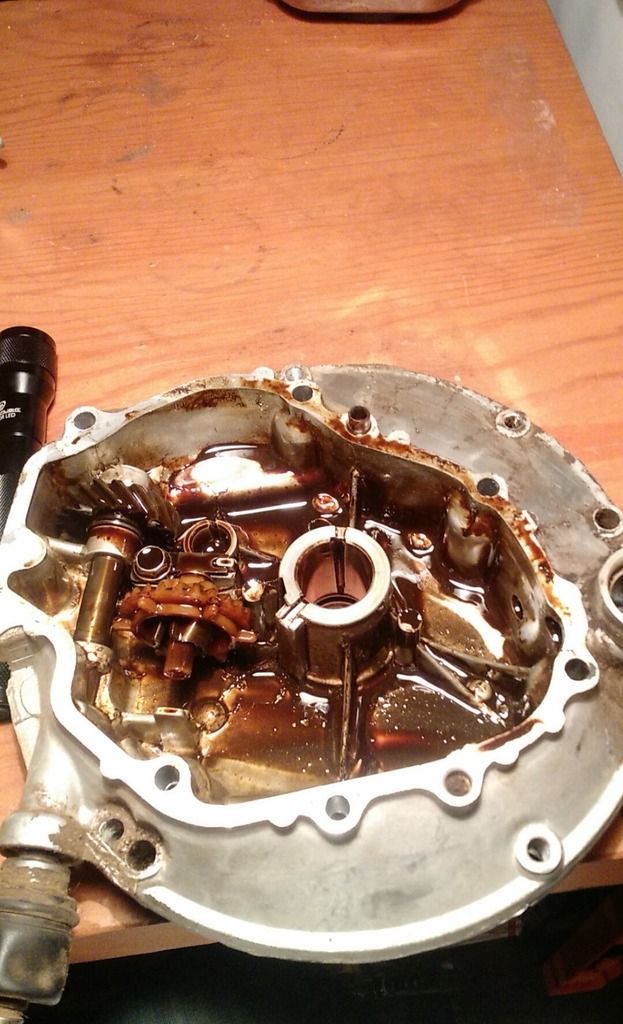
KC_kid


I would feel more comfortable buying a new piston and boring it (if needed) if I could verify why it had such an overheating problem. I don't want that to continue if I rebuild it. If you read my other thread on that topic, I tried everything I could think of. We have Kansas heat but its only about an hours worth of mowing and nothing to strenuous for the mower. I almost always mulch.
I agree, the bottom of the motor looks like it got much hotter than the top. I replaced all of the carb gaskets and remember searching that area for leaks. I'm stumped on the overheating, which is what caused all of this. Here is the oil pan:

#13

KC_kid
KC_kid
Interesting question... I see a Harmony 215 on craigslist with a gxv140 and 2 speed trans... could I buy this and throw the gxv140 onto my mower?? Not sure of exact model number of harmony, I have not contacted them yet.
#14
B
bertsmobile1
B
bertsmobile1
The mounting holes will be on the same centers, that is consistant across the entire range however things like clutches make life interesting.
Also the auxillary drives need to be the same, some are shafts, some ae belts.
Not being an authorised Honda repairer I can be no he;p on that matter.
Also the auxillary drives need to be the same, some are shafts, some ae belts.
Not being an authorised Honda repairer I can be no he;p on that matter.
#15

KC_kid
looks like the drive is different I think, mine is shaft driven and the harmony series is belt
KC_kid
The mounting holes will be on the same centers, that is consistant across the entire range however things like clutches make life interesting.
Also the auxillary drives need to be the same, some are shafts, some ae belts.
Not being an authorised Honda repairer I can be no he;p on that matter.
looks like the drive is different I think, mine is shaft driven and the harmony series is belt
#16

robert@honda
That's correct; all Harmony, Harmony II, HRR, HRS, and HRX models with self-propell use a drive belt. Early Harmony models had GXV engines, while most mowers made in the last 15 years have a GCV160 / GCV190 engines
Early HR, Masters, and self-propelled HRC are shaft-drive. and all are fitted with a GXV engine.
robert@honda
looks like the drive is different I think, mine is shaft driven and the harmony series is belt
That's correct; all Harmony, Harmony II, HRR, HRS, and HRX models with self-propell use a drive belt. Early Harmony models had GXV engines, while most mowers made in the last 15 years have a GCV160 / GCV190 engines
Early HR, Masters, and self-propelled HRC are shaft-drive. and all are fitted with a GXV engine.
#17

KC_kid
KC_kid
Could overfilling the oil be the cause of this damage? I bought a used HRX217 with the GCV190 and when adding oil it says to not screw down the dipstick while measuring the oil level. I think with my GXV140 I would screw the dipstick down when checking oil level... could this have caused overfill and led to this damage?
FYI I bagged and tagged all the engine parts and sold the whole mower & engine on craigslist for $40. The guy had a GXV140 and reused the rest of my mower, kept the engine for parts. I then picked up a HRX217HXA K2 for $100 and cleaned it up real good. Looks to be in good shape so far, haven't really used it yet.
FYI I bagged and tagged all the engine parts and sold the whole mower & engine on craigslist for $40. The guy had a GXV140 and reused the rest of my mower, kept the engine for parts. I then picked up a HRX217HXA K2 for $100 and cleaned it up real good. Looks to be in good shape so far, haven't really used it yet.
#18

KC_kid
Yep, I checked my old Masters manual and it said to not screw in dipstick when checking fill level... What a total idiot move if I caused this catastrophic damage by overfilling the oil... :ashamed:
KC_kid
Could overfilling the oil be the cause of this damage? I bought a used HRX217 with the GCV190 and when adding oil it says to not screw down the dipstick while measuring the oil level. I think with my GXV140 I would screw the dipstick down when checking oil level... could this have caused overfill and led to this damage?
Yep, I checked my old Masters manual and it said to not screw in dipstick when checking fill level... What a total idiot move if I caused this catastrophic damage by overfilling the oil... :ashamed:
#19
B
bertsmobile1
B
bertsmobile1
No
Overfilling can break rings, blow seals bend rods and even crack heads but your damage was due to excessive heat.
Wy is the big question.
Wrong fuel can not do that sort of damage.
Overfilling can break rings, blow seals bend rods and even crack heads but your damage was due to excessive heat.
Wy is the big question.
Wrong fuel can not do that sort of damage.
